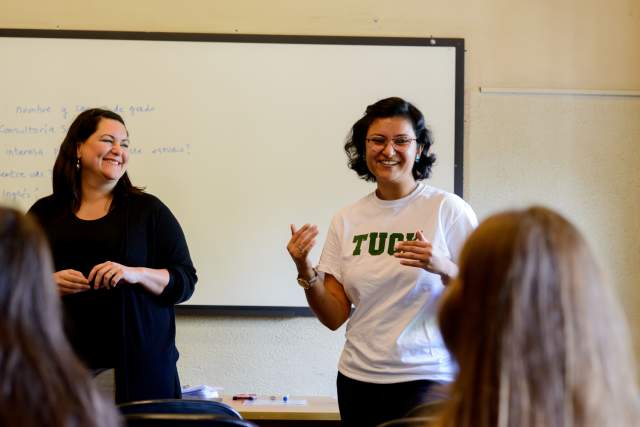Towards the beginning of Fall A* last year, first-year students in the core course Analytics learned about a tool called a decision tree. It’s nothing new or cutting edge, but it is a foundational framework for thinking about decisions under uncertainty and risk. A few days later, those students began working through the Carter Racing case in the core course Managing People. The case is well-known in the MBA world, but there’s a twist at the end and future students shouldn’t have that surprise ruined. Suffice it to say, a car-racing team is trying to decide whether to participate in a race when they still haven’t figured out why their engines have failed in prior races. There’s a lot of money, and the future of the team, on the line.
Daniel Feiler co-teaches Managing People with Jennifer Dannals. The lesson of the Carter Racing case, Feiler explains, is to “not just wave your hands at risk and uncertainty. You need to be really systematic and organized with how you think about and value the outcomes, and be careful about the risks and probabilities.”
Managing People integrates with Management Communications in a case about presenting and defending a point of view. Marketing integrates with Managerial Economics on price elasticity, and with Managing People on how to work in teams. There are dozens of connections like these.
Professors James Smith and Robert Shumsky introduced students to decision trees in Analytics, and then Feiler and Dannals layered the psychology of decision making on top of it. But this was not a coincidence. Before the term started, both sets of professors got together to plan how their lessons would intersect. They all worked on a decision tree for the Carter Racing case, using Tree Plan, the software the students learn how to use in Analytics. Then Feiler and Dannals asked their students to think about how they would approach the case. Many of them began drawing decision trees by hand, or they opened their computers to make digital ones. After a while, Feiler and Dannals made the reveal.
They said to their students: “We actually talked to your teachers in Analytics and here’s the decision tree we came up with together for this case. Does yours look something like this?”
For many of the students, it was an ah-ha moment, seeing the close intersection of their courses. One section of Managing People, in fact, gave the professors a round of applause when they unveiled the decision tree.
This type of coordination and integration is a hallmark of the Tuck curriculum and, arguably, no other business school does it better. In part, it’s facilitated by the school’s size and commitment to a personal, connected, and transformative learning experience. But it’s also just a result of the genial relationship among faculty members, who are more than happy to search out those curricular connections with each other.
Examples abound. Managing People integrates with Management Communications in a case about presenting and defending a point of view. Marketing integrates with Managerial Economics on price elasticity, and with Managing People on how to work in teams. There are dozens of connections like these, turning the core curriculum into a finely crafted web that gives students both the granular detail and the big picture.
*As of academic year 2021 – 2022, “Fall A” is now termed Summer Term and “Fall B” is termed Fall Term.
Connecting Concepts
- What is a ... Regression Analysis?
Regression is the technical term for a model where you use data to make a prediction or explanation. Say you have data on undergraduate GPAs and GMAT scores and want to predict how well someone will do at Tuck. You can use historical data to estimate the relationship between GPAs at Tuck and GMAT scores. The model provides weights on various parameters and ranges of accuracy for forecasts. Marketers use it to understand demand and predict it based on other attributes of products. In Finance, students use it to understand risk-return relationships. How do you actually do it? You’ll have to take Analytics to find out.
- What is a ... tornado chart?
Say you have a spreadsheet model with a cashflow prediction for a new venture. Chances are, a lot of the input numbers are a best-guess. A tornado chart varies each of the input parameters over an established range, which shows you how much the cashflow changes when the inputs change. It’s a very efficient way to display the results of variation, ranked from the most impactful to the least.
- What is ... Prospect Theory?
Economists used to think people acted with perfect rationality. Now they know better, and prospect theory tries to capture some of humanity’s predictable irrationality. The theory holds that we tend to give more weight in our minds to potential losses rather than gains. Being loss-averse, we will pay more to avoid a loss than we would to get an equivalent gain. This shows up in Strategy and Managing People under the heading of goal setting, and in Marketing where price discounts can create new reference points that make subsequent price increases harder to swallow.
- What is a ... Cluster Analysis?
Marketing introduces this tool as a way to segment customers in the Kirin beer case. Customers have many different preferences on beer attributes, creating a monstrous 20-dimensional segmentation problem. Cluster analysis uses an algorithm to separate all beer drinkers into, perhaps, four or five categories, which helps marketers think about targeting those clusters. Analytics takes this application to the next level by teaching students optimization methods in Excel. “Marketing is giving us the context, and then we build on that,” says Professor of Operations Management Robert Shumsky. The tool also appears in Accounting Finance and Corporate Finance.
- What is a ... Monte Carlo Simulation?
Imagine you are trying to predict the outcome of an R&D investment. Since many of the inputs are uncertain, it’s hard to have confidence your prediction. One way to gain confidence is to put a probability distribution around those uncertain inputs and randomly draw input values. You can do this on paper a few times, but computers can do it tens of thousands of times in a few seconds, giving you a nearly omniscient view of how your investment could turn out.
- What is a ... Decision tree?
Put simply, decision trees are a way to help guide decisions. They put a structure around the if-then problems of setting a course where you can’t easily turn back. “By having the language of decision trees to describe the structure of the problem, you can have a much better conversation about it,” says James Smith, the Jack Byrne Distinguished Professor in Decision Science. “You don’t have to waste time building these lists of what could happen; you just build a tree and then you can talk about what you should do.”



